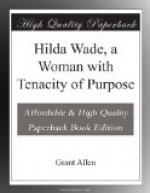By this time, we could easily see we were beginning to produce a most favourable impression. Hilda’s study of Buddhism had stood us in good stead. The chief Lama or abbot motioned to us to be seated, in a much politer mood; after which he and his principal monks held a long and animated conversation together. I gathered from their looks and gestures that the head Lama inclined to regard us as orthodox Buddhists, but that some of his followers had grave doubts of their own as to the depth and reality of our religious convictions.
While they debated and hesitated, Hilda had another splendid idea. She undid her portfolio, and took out of it the photographs of ancient Buddhist topes and temples which she had taken in India. These she produced triumphantly. At once the priests and monks crowded round us to look at them. In a moment, when they recognised the meaning of the pictures, their excitement grew quite intense. The photographs were passed round from hand to hand, amid loud exclamations of joy and surprise. One brother would point out with astonishment to another some familiar symbol or some ancient text; two or three of them, in their devout enthusiasm, fell down on their knees and kissed the pictures.
We had played a trump card! The monks could see for themselves by this time that we were deeply interested in Buddhism. Now, minds of that calibre never understand a disinterested interest; the moment they saw we were collectors of Buddhist pictures, they jumped at once to the conclusion that we must also, of course, be devout believers. So far did they carry their sense of fraternity, indeed, that they insisted upon embracing us. That was a hard trial to Lady Meadowcroft, for the brethren were not conspicuous for personal cleanliness. She suspected germs, and she dreaded typhoid far more than she dreaded the Tibetan cutthroat.
The brethren asked, through the medium of our interpreter, the cook, where these pictures had been made. We explained as well as we could by means of the same mouthpiece, a very earthen vessel, that they came from ancient Buddhist buildings in India. This delighted them still more, though I know not in what form our Ghoorka retainer may have conveyed the information. At any rate, they insisted on embracing us again; after which the chief Lama said something very solemnly to our amateur interpreter.
The cook interpreted. “Priest-sahib say, he too got very sacred thing, come from India. Sacred Buddhist poojah-thing. Go to show it to you.”
We waited, breathless. The chief Lama approached the altar before the recess, in front of the great cross-legged, vapidly smiling Buddha. He bowed himself to the ground three times over, as well as his portly frame would permit him, knocking his forehead against the floor, just as Hilda had done; then he proceeded, almost awestruck, to take from the altar an object wrapped round with gold brocade, and very carefully guarded. Two acolytes accompanied him. In the most reverent way, he slowly unwound the folds of gold cloth, and released from its hiding-place the highly sacred deposit. He held it up before our eyes with an air of triumph. It was an English bottle!




